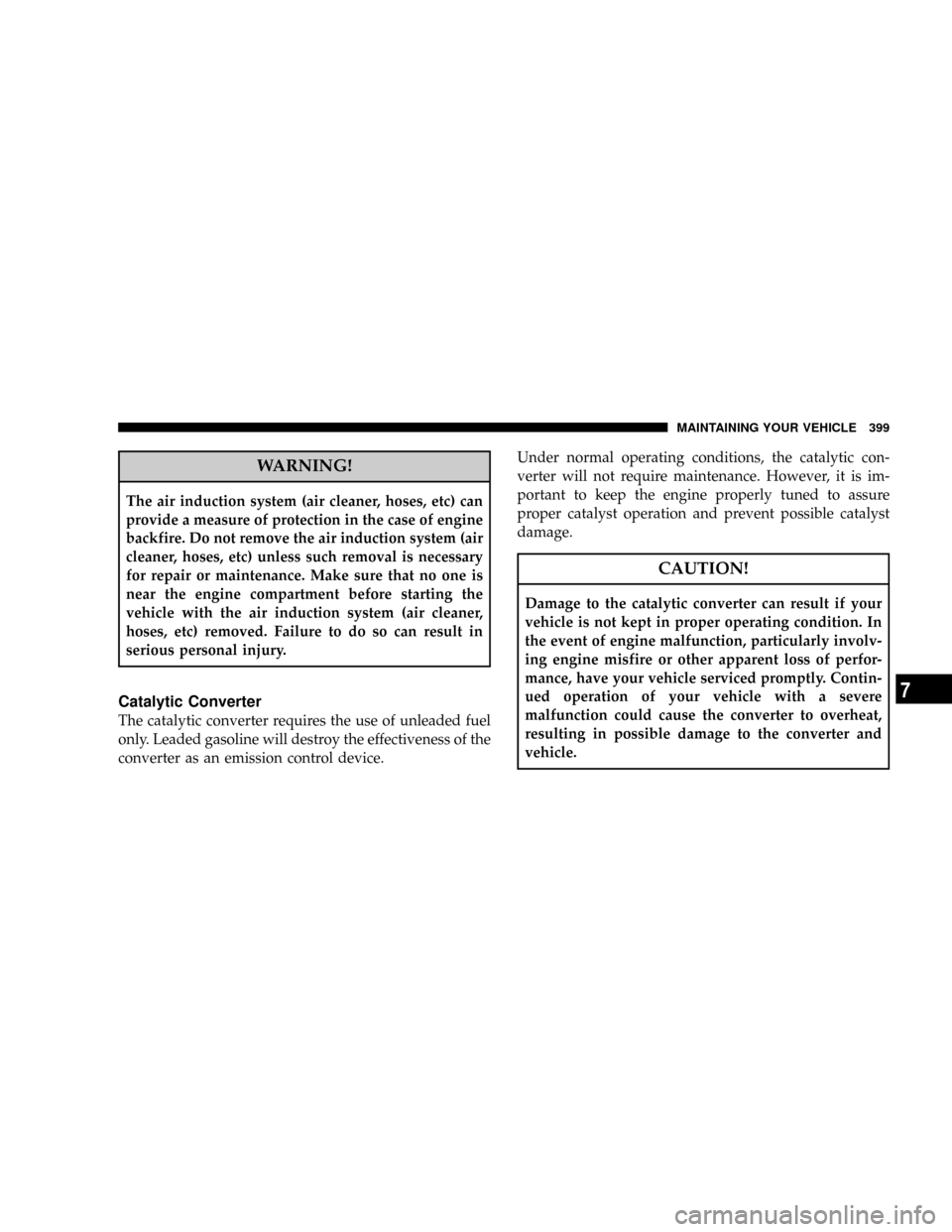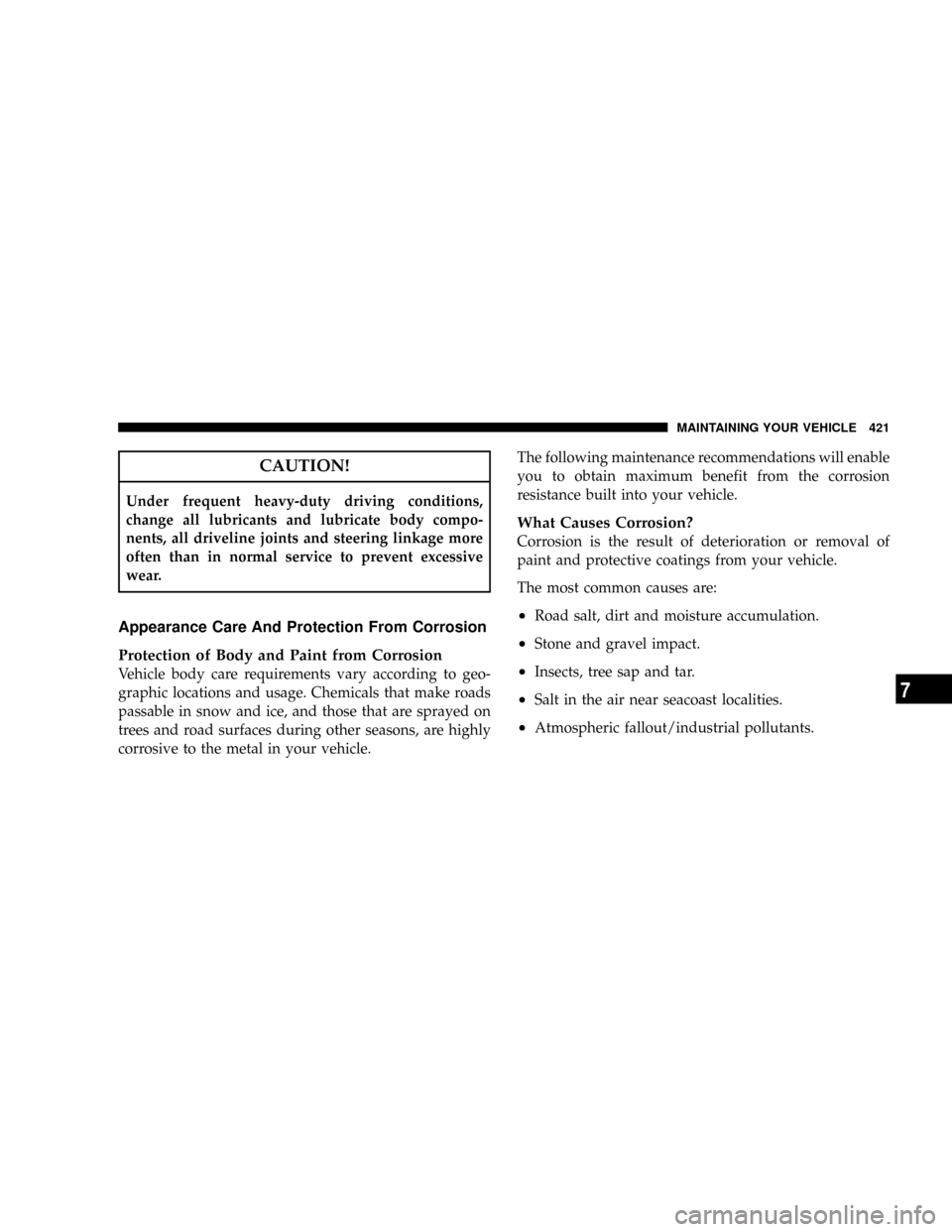Page 383 of 490
MAINTAINING YOUR VEHICLE
CONTENTS
mEngine Compartment ± 3.7L...............386
mEngine Compartment ± 4.7L...............387
mEngine Compartment ± 5.7L...............388
mEngine Compartment ± 3.0L Diesel..........389
mOnboard Diagnostic System Ð OBD II........390
NLoose Fuel Filler Cap Message............391
mEmissions Inspection And Maintenance
Programs............................391
mReplacement Parts......................393mDealer Service.........................393
mMaintenance Procedures..................394
NEngine Oil..........................394
NDrive Belts Ð Check Condition And Tension . . 398
NSpark Plugs.........................398
NSpark Plug Wires.....................398
NEngine Air Cleaner Filter................398
NCatalytic Converter....................399
NCrankcase Emission Control System........400
7
Page 384 of 490

NMaintenance-Free Battery................401
NAir Conditioner Maintenance.............402
NPower Steering Fluid Check..............403
NBody Lubrication.....................405
NWindshield Wiper Blades................405
NWindshield Washers Ð Front And Rear.....405
NExhaust System......................406
NCooling System.......................407
NHoses And Vacuum/Vapor Harnesses.......412
NFuel System Connections................412
NBrake System........................413
NFront/Rear Axle Fluid..................415
NTransfer Case........................416NAutomatic Transmission................417
NMaintenance After Off-Road Driving........420
NAppearance Care And Protection From
Corrosion...........................421
mFuse Panel...........................426
NInterior Fuses........................426
NUnderhood Fuses (Power Distribution
Center)............................429
NUnderhood Fuses (Integrated Power
Module)............................432
mVehicle Storage........................433
mReplacement Bulbs......................434
mBulb Replacement......................435
384 MAINTAINING YOUR VEHICLE
Page 398 of 490

Drive Belts Ð Check Condition and Tension
Belt tension is controlled by means of an automatic
tensioner. No belt tension adjustments are required.
However, belt and belt tensioner condition should be
inspected at the specified intervals, and replaced if re-
quired. See your authorized dealer for service.
At the mileage indicated in the maintenance schedule, all
belts and tensioner should be checked for condition.
Improper belt tension can cause belt slippage and failure.
Belts should be inspected for evidence of cuts, cracks,
glazing, or frayed cords and replaced if there is indication
of damage which could result in belt failure. Low gen-
erator belt tension can cause battery failure.
Also, check belt routing to make sure there is no inter-
ference between the belts and other engine components.
Spark Plugs
Spark plugs must fire properly to assure engine perfor-
mance and emission control. New spark plugs should be
installed at the specified mileage. The entire set should be
replaced if there is any malfunction due to a faulty spark
plug. Refer to ªFluids, Lubricants, and Genuine Partsº in
this section for spark plug information.
Spark Plug Wires
The spark plug wires should be kept clean and properly
connected. Terminals should be fully seated. Cracked,
damaged, or faulty wires should be replaced.
Engine Air Cleaner Filter
Refer to the Maintenance Schedule for recommended
Engine Air Cleaner Filter change intervals.
398 MAINTAINING YOUR VEHICLE
Page 399 of 490

WARNING!
The air induction system (air cleaner, hoses, etc) can
provide a measure of protection in the case of engine
backfire. Do not remove the air induction system (air
cleaner, hoses, etc) unless such removal is necessary
for repair or maintenance. Make sure that no one is
near the engine compartment before starting the
vehicle with the air induction system (air cleaner,
hoses, etc) removed. Failure to do so can result in
serious personal injury.
Catalytic Converter
The catalytic converter requires the use of unleaded fuel
only. Leaded gasoline will destroy the effectiveness of the
converter as an emission control device.Under normal operating conditions, the catalytic con-
verter will not require maintenance. However, it is im-
portant to keep the engine properly tuned to assure
proper catalyst operation and prevent possible catalyst
damage.
CAUTION!
Damage to the catalytic converter can result if your
vehicle is not kept in proper operating condition. In
the event of engine malfunction, particularly involv-
ing engine misfire or other apparent loss of perfor-
mance, have your vehicle serviced promptly. Contin-
ued operation of your vehicle with a severe
malfunction could cause the converter to overheat,
resulting in possible damage to the converter and
vehicle.
MAINTAINING YOUR VEHICLE 399
7
Page 402 of 490
CAUTION!
²It is essential when replacing the cables on the
battery that the positive cable is attached to the
positive post and the negative cable is attached to
the negative post. Battery posts are marked (+)
positive and negative (-) and identified on the
battery case.
²If a ªfast chargerº is used while battery is in the
vehicle, disconnect both vehicle battery cables
before connecting the charger to battery. Do not
use a ªfast chargerº to provide starting voltage.
Air Conditioner Maintenance
For best possible performance, your air conditioner
should be checked and serviced by an Authorized Dealer
at the start of each warm season. This service should
include cleaning of the condenser fins and a performance
test. Drive belt condition should also be checked at this
time.
402 MAINTAINING YOUR VEHICLE
Page 403 of 490

WARNING!
²Use only refrigerants and compressor lubricants
approved by the manufacturer for your air condi-
tioning system. Some unapproved refrigerants are
flammable and can explode, injuring you. Other
unapproved refrigerants or lubricants can cause
the system to fail, requiring costly repairs. Refer to
Section 3 of the Warranty Information Book for
additional warranty information.
²The air conditioning system contains refrigerant
under high pressure. To avoid risk of personal
injury or damage to the system, adding refrigerant
or any repair requiring lines to be disconnected
should be done by an experienced repairman.NOTE:Use only manufacturer approved A/C System
Sealers, Stop Leak Products, Seal Conditioners, Compres-
sor Oil, and Refrigerants.
Refrigerant Recovery and Recycling
R-134a Air Conditioning Refrigerant is a hydrofluorocar-
bon (HFC) that is endorsed by the Environmental Pro-
tection Agency and is an ozone-saving product. How-
ever, the manufacturer recommends that air conditioning
service be performed by dealers or other service facilities
using recovery and recycling equipment.
Power Steering Fluid Check
The power steering system requires the use of Mopart
Hydraulic System Power Steering Fluid (P/N
05142893AA), or equivalent, which meets
DaimlerChrysler Material Standard MS-10838.
MAINTAINING YOUR VEHICLE 403
7
Page 412 of 490

²Make sure that the radiator and coolant recovery
bottle hoses are not kinked or obstructed.
²Keep the front of the radiator clean. If your vehicle is
equipped with air conditioning, keep the front of the
condenser clean, also.
²Do not change the thermostat for summer or winter
operation. If replacement is ever necessary, install
ONLY the correct type thermostat. Other designs may
result in unsatisfactory cooling performance, poor gas
mileage, and increased emissions.
Hoses and Vacuum/Vapor Harnesses
Inspect surfaces of hoses and nylon tubing for evidence
of heat and mechanical damage. Hard or soft spots,
brittle rubber, cracking, tears, cuts, abrasions, and exces-
sive swelling indicate deterioration of the rubber.Pay particular attention to the hoses nearest to high heat
sources such as the exhaust manifold. Inspect hose rout-
ing to be sure hoses do not touch any heat source or
moving component that may cause heat damage or
mechanical wear.
Insure nylon tubing in these areas has not melted or
collapsed. Inspect all hose connections such as clamps
and couplings to make sure they are secure and no leaks
are present. Components should be replaced immedi-
ately if there is any evidence of degradation that could
cause failure.Fuel System Connections
Electronic Fuel Injection high pressure fuel systems are
designed with tubes and special connects, connections
and clamps which have unique material characteristics to
provide adequate sealing and resist attack by deterio-
rated gasoline.
412 MAINTAINING YOUR VEHICLE
Page 421 of 490

CAUTION!
Under frequent heavy-duty driving conditions,
change all lubricants and lubricate body compo-
nents, all driveline joints and steering linkage more
often than in normal service to prevent excessive
wear.
Appearance Care And Protection From Corrosion
Protection of Body and Paint from Corrosion
Vehicle body care requirements vary according to geo-
graphic locations and usage. Chemicals that make roads
passable in snow and ice, and those that are sprayed on
trees and road surfaces during other seasons, are highly
corrosive to the metal in your vehicle.The following maintenance recommendations will enable
you to obtain maximum benefit from the corrosion
resistance built into your vehicle.
What Causes Corrosion?
Corrosion is the result of deterioration or removal of
paint and protective coatings from your vehicle.
The most common causes are:
²Road salt, dirt and moisture accumulation.
²Stone and gravel impact.
²Insects, tree sap and tar.
²Salt in the air near seacoast localities.
²Atmospheric fallout/industrial pollutants.
MAINTAINING YOUR VEHICLE 421
7